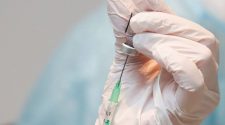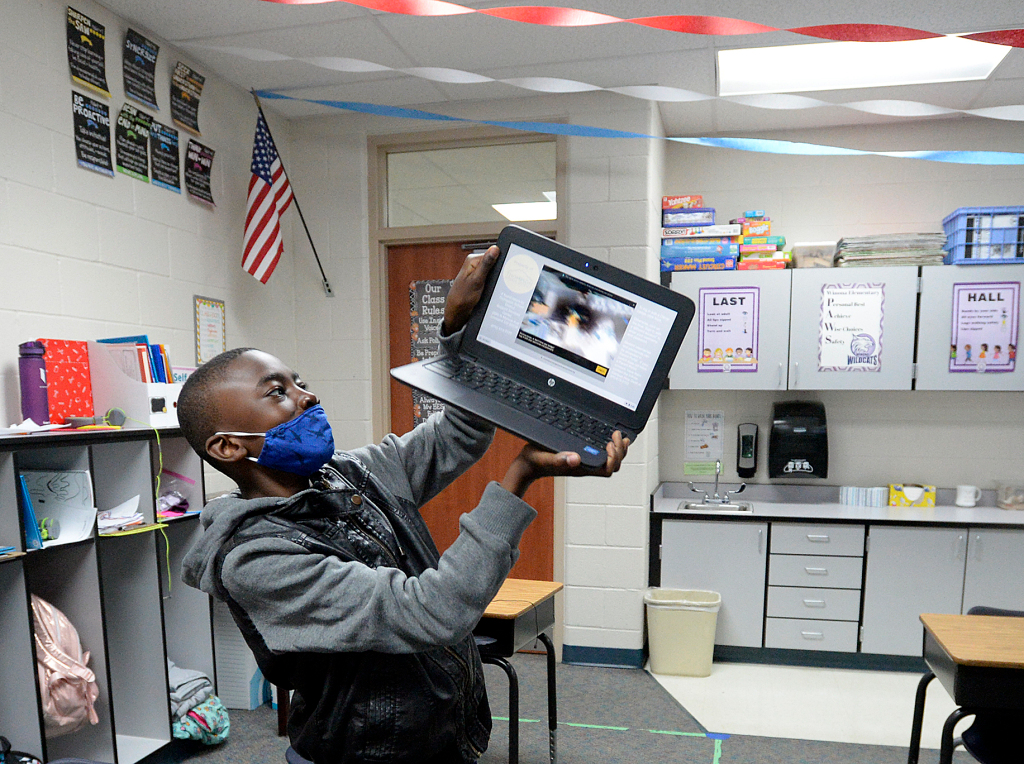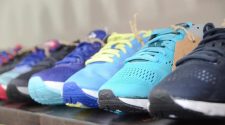On Friday, 185 Chromebooks and 175 iPads marked a milestone for the Thompson School District — ubiquitous technology access for every school in the district.
Winona Elementary School became the last Thompson campus to achieve that status, which essentially means there are enough tablets or computers for each student at the school.
This opens up educational opportunities for the district’s 15,000 students, puts all students on a level playing field and places the district on the same ground as other districts in the state, district officials said.
For Matt Kuhn, the district’s chief technology officer, reaching this level of technology was more than a goal, but also a dream. Before the pandemic, the Thompson School District was among the 40% of districts in Colorado that did not have enough devices for every student.
He was working to reach that level, but with budget constraints — even with bond dollars for technology — he knew it was at least four years out, maybe more, depending on finances.
But then the pandemic hit, highlighting the need for technology with times of fully remote schooling and opening a pot of federal stimulus money to help districts pay for that needed technology.
“The pandemic was horrible for many reasons, but it did come with that silver lining,” Kuhn said. “All of a sudden, I have stimulus money, and I can reach that dream way sooner. … It’s a career highlight to me. I will always remember the day I reached that dream for the district.”
Some new, some old
Now, all of the students at all 30 schools in the district have the same devices as their classmates, and the teachers know what software and learning possibilities they can use for all of their students.
Not all of the devices are new. The district took stock of all the laptops and tablets in its inventory, retired those that were outdated, and grouped the rest into batches of the same device. Those were deployed to some of the schools for some of the students.
But because the district did not have enough devices for all students, it used federal stimulus money, and some of the bond money, to buy more than 6,000 new devices.
Thompson Valley High School was the last high school in the district to reach ubiquitous technology access status on Jan. 25. Last month, Lucile Erwin was the last middle school to reach that level, and then the district started working on the remaining elementary schools. Winona was the very last school.
Now, all the students have the same technology access as their peers, and they all have access to devices that will run the same educational programs, are compatible with standardized tests and will open up new worlds of education to some students.
Jenny Sparks / Loveland Reporter-Herald
Wachara Ruhle, center, Matt Beall, right, and other Thompson School District technology staff members take carts full of computer devices into Winona Elementary School on Friday.
A goal of all schools
Mountain View High School and Conrad Ball Middle School were the first schools in the district to have a device for every student, being chosen in 2014 for a pilot project. When High Plains School opened in 2016, it also had devices for each student, then in 2017, Laurene Edmondson Elementary became the fourth ubiquitous-technology school.
The district began working toward technological equity for all schools, adding devices as budgets allowed. Some were purchased through the Berthoud Schools Fund, others by Rotary, and others through regular school budgets.
The pandemic sped up the process with a pool of funding, but the district also was competing with other schools worldwide that were reaching for the same outcome, affecting the supply chain.
In August 2020, Loveland High School received its new computers and ubiquitous technology status, about five months later than planned because of supply problems.
This Friday, devices were deployed at Winona, and the district reached its goal — earlier than Kuhn could have imagined before the pandemic.
Next year, the new Riverview School in Johnstown will open to students in kindergarten through eighth grade with devices for every student. It will be the 31st ubiquitous-technology school in the district.
Access in three ways
While ubiquitous technology access means each school has a device for each student, the technology is deployed in different ways.
Some schools, including the high schools, check out one device to each student for the year, and the students are allowed to take them home. Some check out the device to the student each day, but the tablet or computer stays at school each night, and some, primarily at the elementary level, have the devices in the classroom, and the students use them only within the room.
Regardless of the way the devices are deployed, the students always have access to the technology they need to learn, Kuhn said.
And with standardized technology available to students at all schools, the district can create efficiencies with district licenses for software instead of different ones for different schools depending on the technology. The students, and the schools, have equitable access, and the teachers can integrate technology into their lessons for all students.
Regular access to technology, every day and not just once a week or less, leads to higher proficiency for students in a technical world.
“When you use technology regularly, you start to master it,” Kuhn said. “Now you can really take it up a notch and create things instead of just consume things. Now instead of just watching a video, you’re making it.”
Also, schools can convert obsolete computer labs into “innovative learning spaces for specialized technology like multimedia, fabrication, robotics, botany and more,” the district announced in a press release. Some schools have already done this, including students at Loveland High School who in 2019 opened a podcast studio in a former computer lab space, creating and learning on a new level.
Moving forward
Now that the district has reached full ubiquitous technology access, Kuhn hopes to be able to maintain the devices. He said their lifespan is about five years, and with a mix of new and older devices, he has planned a replacement cycle, buying new devices for six schools each year as some become obsolete.
This means each school would be refreshed every five years.
“The challenge now is to create yearly budgets that can sustain a replacement of one-fifth of the student device fleet per year,” said Kuhn. “This is the only way it’s going to work. It would be a terrible shame to see a school go non-UTA because we had to yank their devices because they’re obsolete. … I would hate to have to take those steps back.”
















